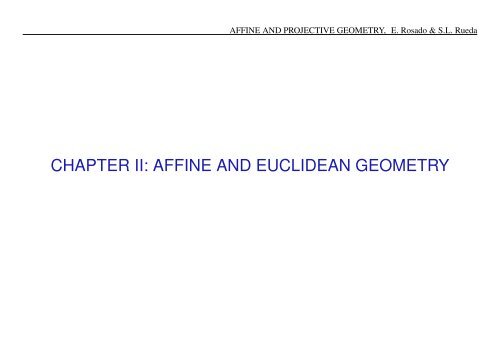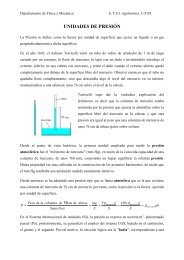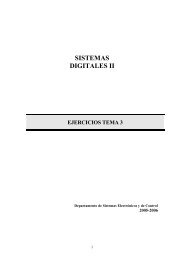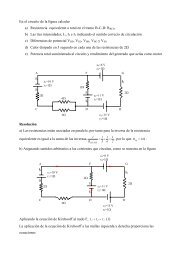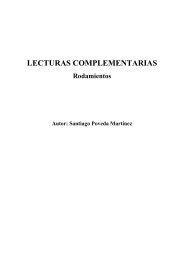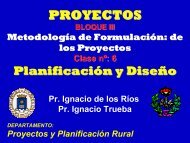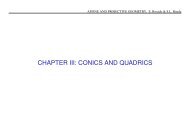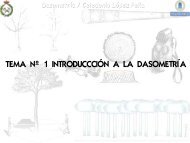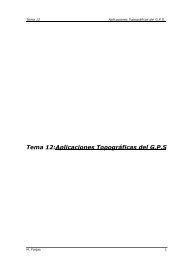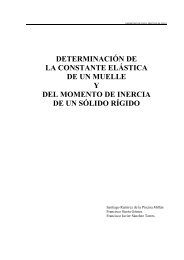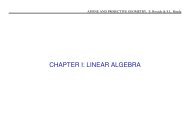CHAPTER II: AFFINE AND EUCLIDEAN GEOMETRY - OCW UPM
CHAPTER II: AFFINE AND EUCLIDEAN GEOMETRY - OCW UPM
CHAPTER II: AFFINE AND EUCLIDEAN GEOMETRY - OCW UPM
Create successful ePaper yourself
Turn your PDF publications into a flip-book with our unique Google optimized e-Paper software.
<strong>AFFINE</strong> <strong>AND</strong> PROJECTIVE <strong>GEOMETRY</strong>, E. Rosado & S.L. Rueda<br />
<strong>CHAPTER</strong> <strong>II</strong>: <strong>AFFINE</strong> <strong>AND</strong> <strong>EUCLIDEAN</strong> <strong>GEOMETRY</strong>
<strong>AFFINE</strong> <strong>AND</strong> PROJECTIVE <strong>GEOMETRY</strong>, E. Rosado & S.L. Rueda<br />
1. <strong>AFFINE</strong> SPACE<br />
1.1 Definition of affine space<br />
A real affine space is a triple (A, V, φ) where A is a set of points, V is a real<br />
vector space and φ: A × A −→ V is a map verifying:<br />
1. ∀P ∈ A and ∀u ∈ V there exists a unique Q ∈ A such that<br />
φ(P, Q) = u.<br />
2. φ(P, Q) + φ(Q, R) = φ(P, R) for everyP, Q, R ∈ A.<br />
Notation. We will write φ(P, Q) = P Q. The elements contained on the set A<br />
are called points of A and we will say that V is the vector space associated<br />
to the affine space (A, V, φ). We define the dimension of the affine space<br />
(A, V, φ) as<br />
dim A = dim V.
Examples<br />
<strong>AFFINE</strong> <strong>AND</strong> PROJECTIVE <strong>GEOMETRY</strong>, E. Rosado & S.L. Rueda<br />
1. Every vector space V is an affine space with associated vector space<br />
V . Indeed, in the triple (A, V, φ), A =V and the map φ is given by<br />
φ: A × A −→ V, φ(u, v) = v − u.<br />
2. According to the previous example, (R 2 , R 2 , φ) is an affine space of<br />
dimension 2, (R 3 , R 3 , φ) is an affine space of dimension 3. In general<br />
(R n , R n , φ) is an affine space of dimension n.<br />
1.1.1 Properties of affine spaces<br />
Let (A, V, φ) be a real affine space. The following statemens hold:<br />
1. φ(P, Q) = 0 if and only if P = Q.<br />
2. φ(P, Q) = −φ(Q, P ), ∀P, Q ∈ A.<br />
3. φ(P, Q) = φ(R, S) if and only if φ(P, R) = φ(Q, S).
<strong>AFFINE</strong> <strong>AND</strong> PROJECTIVE <strong>GEOMETRY</strong>, E. Rosado & S.L. Rueda<br />
1.2 Affine coordinate system<br />
Let A be an affine space of dimension n with associated vector space V .<br />
Definition of affine coordinate system<br />
A set of n + 1 points {P 0 ; P 1 , . . . , P n } of an affine space (A, V, φ) is an affine<br />
coordinate system of A if the vector set { P 0 P 1 , . . . , P 0 P n<br />
}<br />
in a basis of the<br />
vector space V .<br />
A point P 0 ∈ A such that { P 0 P 1 , . . . , P 0 P n<br />
}<br />
is a basis of V , is called origin of<br />
the coordinate system {P 0 ; P 1 , . . . , P n }.<br />
Proposition<br />
Given a point P 0 ∈ A there exists an affine coordinate system of A in which<br />
P 0 is the origin.<br />
Corollary<br />
Given a point O ∈ A and a basis B of V , we have an affine coordinate<br />
system of A, denoted R = {O; B}.
<strong>AFFINE</strong> <strong>AND</strong> PROJECTIVE <strong>GEOMETRY</strong>, E. Rosado & S.L. Rueda<br />
Definition of coordinates<br />
We call coordinates of a point P ∈ A with respect to a cartesian coordinate<br />
system R = {O; B} of the affine space A to the coordinates of the vector<br />
OP with respect to the basis B of the vector space V ; this is, the n-tuple<br />
(α 1 , . . . , α n ) such that<br />
OP = α 1 u 1 + · · · + α n u n<br />
where u 1 , . . . , u n are the vectors of the basis B.<br />
Example<br />
Let R = {O(0, 0, 0); B c } be an affine coordinate system of the affine space<br />
(R 3 , R 3 , φ) of dimension 3, where B c is the standard basis of R 3 .<br />
Let us consider the coordinate system R ′ = {O ′ ; B ′ } with O ′ (1, 2, −1) and<br />
B ′ = {u 1 , u 2 , u 3 }. The vectors u 1 = (1, 0, 0), u 2 = (1, 1, 0), u 3 = (1, 1, 1) form a<br />
basis of V as we have ∣ ∣∣∣∣∣ 1 1 1<br />
0 1 1<br />
0 0 1 ∣ ≠ 0
<strong>AFFINE</strong> <strong>AND</strong> PROJECTIVE <strong>GEOMETRY</strong>, E. Rosado & S.L. Rueda<br />
so the vector set {u 1 , u 2 , u 3 } is linearly independent (we know that a linearly<br />
independent set with 3 vectors in a vector space V of dimension 3 is a<br />
basis).<br />
Let P be a point with coordinates (5, 5, 0) with respect to R , this is,<br />
P (5, 5, 0) R ⇐⇒ OP = 5u 1 + 5u 2 + 0u 3 .<br />
We are going to calculate the coordinates of P with respect to R ′ :<br />
thus<br />
O ′ P = (5 − 1, 5 − 2, 0 + 1) = (4, 3, 1),<br />
O ′ P = x 1 u 1 + x 2 u 2 + x 3 u 3 = x 1 (1, 0, 0) + x 2 (1, 1, 0) + x 3 (1, 1, 1)<br />
= (x 1 + x 2 + x 3 , x 2 + x 3 , x 3 ),<br />
⎧<br />
⎨<br />
⎩<br />
4 = x 1 + x 2 + x 3<br />
3 = x 2 + x 3<br />
1 = x 3<br />
=⇒<br />
⎧<br />
⎨<br />
⎩<br />
x 1 = 1<br />
x 2 = 2<br />
x 3 = 1<br />
and so, (1, 2, 1) are the coordinates of P with respect to R ′ : P (1, 2, 1) R ′.
Change of affine coordinates<br />
<strong>AFFINE</strong> <strong>AND</strong> PROJECTIVE <strong>GEOMETRY</strong>, E. Rosado & S.L. Rueda<br />
We will limit our study to the case of an affine space of dimension 2.<br />
Let A be an affine space of dimension 2 with associated vector space V .<br />
Let B = {u 1 , u 2 } and B ′ = {u ′ 1, u ′ 2} be two basis of V and R = {O; B},<br />
R ′ = {O ′ ; B ′ } two affine coordinate systems of A.<br />
Let us consider P ∈ A, and let (x 1 , x 2 ) be the coordinates of P with respect<br />
to R and (x ′ 1, x ′ 2) the coordinates of P with respect to R ′ ; this is,<br />
OP = x 1 u 1 + x 2 u 2 ,<br />
and O ′ P = x ′ 1u ′ 1 + x ′ 2u ′ 2.<br />
What is the relationship between (x 1 , x 2 ) and (x ′ 1, x ′ 2)?<br />
We know that<br />
OP = OO ′ + O ′ P .
<strong>AFFINE</strong> <strong>AND</strong> PROJECTIVE <strong>GEOMETRY</strong>, E. Rosado & S.L. Rueda<br />
Let (a, b) be the coordinates of O ′ with respect to R; this is,<br />
and let<br />
this is,<br />
OO ′ = au 1 + bu 2 ,<br />
(a 11 , a 21 ) be the coordinates of u ′ 1 with respect to the basis B,<br />
(a 12 , a 22 ) be the coordinates of u ′ 2 with respect to the basis B;<br />
u ′ 1 = a 11 u 1 + a 21 u 2 ,<br />
u ′ 2 = a 12 u 1 + a 22 u 2 .<br />
If we substitute all this in OP = OO ′ + O ′ P we obtain:<br />
OP = OO ′ + O ′ P<br />
= au 1 + bu 2 + x ′ 1u ′ 1 + x ′ 2u ′ 2<br />
= au 1 + bu 2 + x ′ 1 (a 11 u 1 + a 21 u 2 ) + x ′ 2 (a 12 u 1 + a 22 u 2 )<br />
= (a + x ′ 1a 11 + x ′ 2a 12 ) u 1 + (b + x ′ 1a 21 + x ′ 2a 22 ) u 2 ,
<strong>AFFINE</strong> <strong>AND</strong> PROJECTIVE <strong>GEOMETRY</strong>, E. Rosado & S.L. Rueda<br />
and since OP = x 1 u 1 + x 2 u 2 , if we equate the coefficients we have:<br />
{<br />
x1 = a + x ′ 1a 11 + x ′ 2a 12<br />
x 2 = b + x ′ 1a 21 + x ′ 2a 22<br />
We can also write this equation system as a matrix equation:<br />
⎛ ⎞ ⎛ ⎞ ⎛ ⎞<br />
1 1 0 0 1<br />
⎝ x 1<br />
⎠ = ⎝ a a 11 a 12<br />
⎠ ⎝ x ′ ⎠<br />
1 .<br />
x 2 b a 21 a 22 x ′ 2<br />
Let us consider the general case. Let A be an n-dimensional affine space,<br />
and let R = {O; B = {u 1 , . . . , u n }} and R ′ = {O ′ ; B ′ = {u ′ 1, . . . , u ′ 2}} be two<br />
affine coordinate systems of A.
<strong>AFFINE</strong> <strong>AND</strong> PROJECTIVE <strong>GEOMETRY</strong>, E. Rosado & S.L. Rueda<br />
Let (x 1 , . . . , x n ) be the coordinates of P with respect to R and (x ′ 1, . . . , x ′ n)<br />
the coordinates of P with respect to R ′ then we have:<br />
⎛ ⎞ ⎛<br />
⎞ ⎛ ⎞<br />
1 1 0 · · · 0 1<br />
x 1<br />
⎜ ⎟<br />
⎝ . ⎠ = a 1 a 11 · · · a 1n<br />
x ′ 1<br />
⎜<br />
⎟ ⎜ ⎟<br />
⎝ . .<br />
... . ⎠ ⎝ . ⎠<br />
x n a n a n1 · · · a nn x ′ n<br />
where<br />
(a 1 , . . . , a n ) are the coordinates of O ′ with respect toR,<br />
(a 11 , . . . , a n1 ) are the coordinates of u ′ 1 with respect to the basis B,<br />
.<br />
(a 1n , . . . , a nn ) are the coordinates of u ′ 1 with respect to the basis B.
We can also write it as follows:<br />
⎛ ⎞ ⎛<br />
x 1<br />
⎝ . ⎠ = ⎝<br />
x n<br />
<strong>AFFINE</strong> <strong>AND</strong> PROJECTIVE <strong>GEOMETRY</strong>, E. Rosado & S.L. Rueda<br />
⎞ ⎛<br />
a 1<br />
. ⎠ + A ⎝<br />
a n<br />
where A is the matrix of change of basis from B ′ to B:<br />
⎛<br />
⎞<br />
a 11 · · · a 1n<br />
A = ⎝ .<br />
... . ⎠ .<br />
· · · a nn<br />
a n1<br />
x ′ 1<br />
.<br />
x ′ n<br />
⎞<br />
⎠<br />
The matrix<br />
⎛<br />
M f (R ′ , R) = ⎜<br />
⎝<br />
⎞<br />
1 0 · · · 0<br />
a 1 a 11 · · · a 1n<br />
⎟<br />
. .<br />
... . ⎠<br />
a n a n1 · · · a nn<br />
is the change of coordinates matrix from R ′ to R.
<strong>AFFINE</strong> <strong>AND</strong> PROJECTIVE <strong>GEOMETRY</strong>, E. Rosado & S.L. Rueda<br />
Example<br />
In the affine space (A 2 , V 2 , φ) we consider the coordinate systems R =<br />
{O; B = {u 1 , u 2 }}, R ′ = {O ′ ; B ′ = {u ′ 1, u ′ 2}} with<br />
OO ′ = 3u 1 + 3u 2 , u ′ 1 = 2u 1 − u 2 , u ′ 2 = −u 1 + 2u 2 .<br />
1. Determine the change of coordinates matrix from R ′ to R.<br />
We have<br />
OP = OO ′ + O ′ P = 3u 1 + 3u 2 + y 1 (2u 1 − u 2 ) + y 2 (−u 1 + 2u 2 )<br />
= (3 + 2y 1 − y 2 ) u 1 + (3 − y 1 + 2y 2 ) u 2 ,<br />
so {<br />
x1 = 3 + 2y 1 − y 2<br />
this is,<br />
M f (R ′ , R) =<br />
x 2 = 3 − y 1 + 2y 2<br />
⎛<br />
⎝<br />
1 0 0<br />
3 2 −1<br />
3 −1 2<br />
⎞<br />
⎠
<strong>AFFINE</strong> <strong>AND</strong> PROJECTIVE <strong>GEOMETRY</strong>, E. Rosado & S.L. Rueda<br />
2. Determine the change of coordinates matrix from R to R ′ .<br />
⎛ ⎞−1<br />
⎛ ⎞<br />
1 0 0<br />
1 0 0<br />
M f (R, R ′ ) = M f (R ′ , R) −1 = ⎝ 3 2 −1 ⎠ = ⎝ −3 2 1 ⎠<br />
3 3<br />
3 −1 2<br />
−3 1 3<br />
3. The coordinates of a point P with respect to the coordinate system R<br />
are (3, 5). Determine the coordinates of P in R ′ .<br />
⎛ ⎞ ⎛ ⎞ ⎛ ⎞ ⎛ ⎞<br />
1 1 0 0 1<br />
M f (R, R ′ ) ⎝ 3 ⎠ = ⎝ −3 2 1 ⎠ ⎝<br />
3 3<br />
3 ⎠ = ⎝ ⎠<br />
5<br />
5<br />
−3 1 3<br />
4. The coordinates of a point Q with respect to the coordinate system R ′<br />
are (2, 3). Determine the coordinates of Q in R.<br />
⎛ ⎞ ⎛ ⎞ ⎛ ⎞ ⎛ ⎞<br />
1 1 0 0 1 1<br />
M f (R ′ , R) ⎝ 2 ⎠ = ⎝ 3 2 −1 ⎠ ⎝ 2 ⎠ = ⎝ 4 ⎠ .<br />
3 3 −1 2 3 7<br />
2<br />
3<br />
1<br />
2<br />
3<br />
4<br />
3<br />
2<br />
3
1.3 Affine subspace<br />
<strong>AFFINE</strong> <strong>AND</strong> PROJECTIVE <strong>GEOMETRY</strong>, E. Rosado & S.L. Rueda<br />
Definition of affine subspace<br />
Let (A, V, φ) be a real affine space. A subset L ⊂ A is an affine subspace<br />
of A if given a point P ∈ L the set<br />
W (L) = {P Q | Q ∈ L}<br />
is a vector subspace of V .<br />
If L ⊂ A is an affine subspace, the vector subspace W (L) that verifies<br />
the previous definition is called vector subspace associated to L and it is<br />
denoted by L.<br />
Proposition<br />
The former definition does not depend on the fixed point P .<br />
Proposition<br />
Let (A, V, φ) be a real affine space and L an affine subspace of A. The triple<br />
(L, L, φ) is an affine space.
<strong>AFFINE</strong> <strong>AND</strong> PROJECTIVE <strong>GEOMETRY</strong>, E. Rosado & S.L. Rueda<br />
Proposition<br />
Let (A, V, φ) be a real affine space and L an affine subspace of A. For every<br />
point P ∈ A and each vector subspace W ⊂ V the set<br />
S(P, W ) = {X ∈ A | P X ∈ W }<br />
is an affine subspace of A that we denote by P + W .<br />
Definition of dimension of an affine subspace<br />
Let (A, V, φ) be a real affine space and L an affine subspace of A. The dimension<br />
of L is defined as the dimension of its associated vector subspace:<br />
dim L = dim L.<br />
Notation Let (A, V, φ) be a real affine space of dimension n. The subspaces<br />
of dimension 0 are the points of A. The subspaces of dimension 1, 2 and<br />
n − 1 are called lines, planes and hyperplanes, respectively.
<strong>AFFINE</strong> <strong>AND</strong> PROJECTIVE <strong>GEOMETRY</strong>, E. Rosado & S.L. Rueda<br />
1.3.1. Equations of an affine subspace<br />
Let (A, V, φ) be an affine subspace with affine coordinate system R =<br />
{O; B}, B = {e 1 , . . . , e n }. Let L ⊂ A be an affine subspace of A of dimension<br />
k; this is, L = P + L with L = 〈u 1 , . . . , u k 〉.<br />
Suppose (a 1 , . . . , a n ) are the coordinates of a point P in the coordinate system<br />
R and<br />
⎧⎪ ⎨<br />
⎪ ⎩<br />
u 1 = a 11 e 1 + · · · + a n1 e n<br />
u 2 = a 12 e 1 + · · · + a n2 e n<br />
.<br />
u k = a 1k e 1 + · · · + a nk e n
Parametric equations<br />
<strong>AFFINE</strong> <strong>AND</strong> PROJECTIVE <strong>GEOMETRY</strong>, E. Rosado & S.L. Rueda<br />
A point X(x 1 , . . . , x n ) R ∈ L if and only if there exist λ 1 , . . . , λ k ∈ R such that<br />
this is,<br />
OX = OP + λ 1 u 1 + · · · + λ k u k ;<br />
(x 1 , . . . , x n ) = (a 1 , . . . , a n ) + λ 1 (a 11 , . . . , a n1 ) + · · · + λ k (a 1k , . . . , a nk )<br />
or, equivalently<br />
⎧<br />
⎨<br />
⎩<br />
x 1 = a 1 + λ 1 a 11 + · · · + λ k a 1k<br />
.<br />
x n = a n + λ 1 a n1 + · · · + λ k a nk<br />
which are the parametric equations of the subspace L.
Cartesian equations<br />
<strong>AFFINE</strong> <strong>AND</strong> PROJECTIVE <strong>GEOMETRY</strong>, E. Rosado & S.L. Rueda<br />
A point X(x 1 , . . . , x n ) R ∈ L if and only if the vector<br />
P X = (x 1 − a 1 , . . . , x n − a n ) ∈ 〈u 1 , . . . , u k 〉 .<br />
As we are assuming that the vectors u 1 , . . . , u k are linearly independent (if<br />
they were not, we would remove those which were a linear combination of<br />
the rest) we have<br />
⎛<br />
⎞<br />
a 11 · · · a 1k<br />
rank ⎝ .<br />
... . ⎠ = k.<br />
· · · a nk<br />
a n1<br />
Therefore, P X = (x 1 − a 1 , . . . , x n − a n ) ∈ 〈u 1 , . . . , u k 〉 if and only if<br />
⎛<br />
⎞<br />
x 1 − a 1 a 11 · · · a 1k<br />
rank ⎝ . .<br />
... . ⎠ = k.<br />
x n − a n a n1 · · · a nk<br />
As we are imposing the rank to be k we obtain n − k minors of order k + 1.<br />
This is, we obtain n − k equations with n unknowns: (x 1 , . . . , x n ).
<strong>AFFINE</strong> <strong>AND</strong> PROJECTIVE <strong>GEOMETRY</strong>, E. Rosado & S.L. Rueda<br />
Observation Let (A, V, φ) be an affine space with affine coordinate system<br />
R = {O; B}, B = {e 1 , . . . , e n }. Let<br />
⎧<br />
⎨ a 11 x 1 + · · · + a n1 x n = b 1<br />
L ≡<br />
.<br />
⎩<br />
a 1r x 1 + · · · + a nr x n = b r<br />
be the cartesian equations of an affine subspace L of dimension n − r.<br />
Notice that the cartesian equations of an affine subspace L of dimension<br />
n − r are a system of r non homogeneous linear equations. If P, Q ∈ L<br />
then the vector u = P Q satisfies the equations of the homogeneous linear<br />
system associated with L.
Proof If P (p 1 , . . . , p n ) and Q(q 1 , . . . , q n ) then<br />
and for i = 1 . . . r, we have<br />
<strong>AFFINE</strong> <strong>AND</strong> PROJECTIVE <strong>GEOMETRY</strong>, E. Rosado & S.L. Rueda<br />
u = P Q = (q 1 − p 1 , . . . , q n − p n )<br />
a 1i (p 1 − q 1 ) + · · · + a ni (p 1 − q 1 )<br />
= a 1i p 1 + · · · + a ni p n − (a 1i q 1 + · · · + a ni q n ) =<br />
P,Q∈L<br />
b i − b i<br />
= 0.<br />
So, the system of cartesian equations of the vector space associated with<br />
L are:<br />
⎧<br />
⎨ a 11 x 1 + · · · + a n1 x n = 0<br />
L ≡<br />
.<br />
⎩<br />
a 1r x 1 + · · · + a nr x n = 0
Equations of a line<br />
<strong>AFFINE</strong> <strong>AND</strong> PROJECTIVE <strong>GEOMETRY</strong>, E. Rosado & S.L. Rueda<br />
Let (A, V, φ) be affine space with an affine coordinate system R = {O; B},<br />
B = {e 1 , . . . , e n }. A affine line r ⊂ A is an affine subspace of dimension 1;<br />
this is, r = P + 〈u〉. Let us suppose that (a 1 , . . . , a n ) are the coordinates of a<br />
point P in the coordinate system R and<br />
So, a point X ∈ r if and only if<br />
u = u 1 e 1 + · · · + u n e n .<br />
OX = OP + λu,<br />
this is, if (x 1 , . . . , x n ) are the coordinates of X in the coordinate system R<br />
then,<br />
(x 1 , . . . , x n ) = (a 1 , . . . , a n ) + λ(u 1 , . . . , u n )<br />
or, equivalently the parametric equations of the line r.<br />
⎧<br />
⎨ x 1 = a 1 + λ 1 u 1<br />
.<br />
⎩<br />
x n = a n + λ 1 u n
<strong>AFFINE</strong> <strong>AND</strong> PROJECTIVE <strong>GEOMETRY</strong>, E. Rosado & S.L. Rueda<br />
If we suppose u 1 ≠ 0 (some u i is non zero since the vector u is not null), the<br />
former system is written as follows:<br />
x 1 − a 1<br />
u 1<br />
= · · · = x n − a n<br />
u n<br />
which is the continous equation of the line r.<br />
To finish, X(x 1 , . . . , x n ) R ∈ L if and only if XP ∈ 〈u〉 if and only if XP and u<br />
are proportional. Therefore, XP ∈ 〈u〉 if and only if<br />
⎛<br />
⎞<br />
x 1 − a 1 u 1<br />
rank ⎝ . . ⎠ = 1.<br />
x n − a n u n<br />
As we are imposing the rank to be 1 we obtain n − 1 minors of order 2. This<br />
is, we obtain n − 1 cartesian equations of r.
Equations of a hyperplane<br />
<strong>AFFINE</strong> <strong>AND</strong> PROJECTIVE <strong>GEOMETRY</strong>, E. Rosado & S.L. Rueda<br />
Let (A, V, φ) be an affine space with affine coordinate system R = {O; B},<br />
B = {e 1 , . . . , e n }. An affine hyperplane H ⊂ A in an affine subspace of<br />
dimension n − 1; it is therefore given by just one equation<br />
a 1 x 1 + · · · + a n x n = b.<br />
Observation An affine subspace L of dimension k is the intersection of n−k<br />
independent hyperplanes.<br />
Example 1 Obtain the parametric equations of the affine subspace L of A<br />
which has the following cartesian equations with respect to R :<br />
L ≡<br />
{<br />
x1 + x 2 + 2x 3 = 1<br />
2x 2 − x 3 = 1
<strong>AFFINE</strong> <strong>AND</strong> PROJECTIVE <strong>GEOMETRY</strong>, E. Rosado & S.L. Rueda<br />
First method.<br />
We solve the non homogeneous linear system of equations defining L. The<br />
coefficient matrix of the system is:<br />
( ) 1 1 2<br />
A =<br />
0 2 −1<br />
whose rank is 2. As<br />
( ) 1 1<br />
rank = 2<br />
0 2<br />
if we take x 3 = λ the system can be written as follows:<br />
⎧<br />
{ ⎨ x<br />
x1 + x 2 + 2x 3 = 1<br />
1 + x 2 = 1 − 2λ<br />
=⇒ 2x<br />
2x 2 − x 3 = 1 ⎩ 2 = 1 + λ<br />
x 3 = λ<br />
This is,<br />
⎧<br />
⎨ x 1 = 1 2 − 5 2 λ<br />
x<br />
⎩ 2 = 1 2 + 1 2 λ<br />
x 3 = λ<br />
which are the parametric equations of L.
<strong>AFFINE</strong> <strong>AND</strong> PROJECTIVE <strong>GEOMETRY</strong>, E. Rosado & S.L. Rueda<br />
Second method.<br />
As dim L = 3 − rank(A) = 3 − 2 = 1, L is a line, to determine L it is enough<br />
to give a point P ∈ L and a vector v that generates the vector subspace<br />
L = 〈v〉. A point P ∈ L must satisfy the system of equations defined by L;<br />
for example take P (3, 0, −1).<br />
A vector that generates the vector subspace L is a nontrivial solution of the<br />
homogeneous linear system:<br />
{<br />
x1 + x 2 + 2x 3 = 0<br />
2x 2 − x 3 = 0<br />
For example the vector u = (−5, 1, 2).<br />
Therefore, L = P + L = P + 〈u〉. So, X(x 1 , x 2 , x 3 ) ∈ L if and only if<br />
(x 1 , x 2 , x 3 ) = (3, 0, −1) + λ(−5, 1, 2); this is,<br />
⎧<br />
⎨<br />
⎩<br />
x 1 = 3 − 5λ<br />
x 2 = λ<br />
x 3 = −1 + 2λ<br />
which are the parametric equations of L.
Example 2<br />
<strong>AFFINE</strong> <strong>AND</strong> PROJECTIVE <strong>GEOMETRY</strong>, E. Rosado & S.L. Rueda<br />
Let (A, V, φ) be an affine space with affine coordinate system R = {O; B},<br />
B = {e 1 , e 2 , e 3 }. Obtain the cartesian equations of the affine subspace L =<br />
P + L, where P (1, 2, −1) R and L = 〈u 1 , u 2 〉 with u 1 = (1, 2, −1) and u 2 =<br />
(2, 1, 1).<br />
Solution.<br />
The vectors u 1 , u 2 which generate L are linearly independent. Therefore,<br />
dim L = 2.<br />
A point X(x 1 , x 2 , x 3 ) R ∈ L if and only if the vector<br />
P X = (x 1 − 1, x 2 − 2, x 3 + 1) ∈ 〈u 1 , u 2 〉 ;<br />
this is, if and only if<br />
⎛<br />
x 1 − 1 1<br />
⎞<br />
2<br />
rank ⎝ x 2 − 2 2 1 ⎠ = 2 ⇐⇒ 0 =<br />
x 3 + 1 −1 1<br />
Therefore L ≡ x 1 − x 2 − x 3 = 0.<br />
∣<br />
x 1 − 1 1 2<br />
x 2 − 2 2 1<br />
x 3 + 1 −1 1<br />
∣ = 3x 1 − 3x 2 − 3x 3 .
<strong>AFFINE</strong> <strong>AND</strong> PROJECTIVE <strong>GEOMETRY</strong>, E. Rosado & S.L. Rueda<br />
1.3.2 Intersection and sum of affine subspaces<br />
Let (A, V, φ) be a real affine space and L 1 , L 2 two affine subspaces of A.<br />
The intersection set of L 1 and L 2 :<br />
L 1 ∩ L 2 = {P | P ∈ L 1 y P ∈ L 2 }<br />
is an affine subspace of A. If the intersection is not empty, L 1 ∩ L 2 ≠ ∅, then<br />
L 1 ∩ L 2 = L 1 ∩ L 2 .<br />
We define the sum of L 1 and L 2 as the smallest affine subspace that contains<br />
L 1 and L 2 and it is denotated by L 1 +L 2 . If L 1 = P 1 +L 1 and L 2 = P 2 +L 2<br />
then<br />
L 1 + L 2 = P 1 + L 1 + L 2 + 〈 P 1 P 2<br />
〉<br />
.
<strong>AFFINE</strong> <strong>AND</strong> PROJECTIVE <strong>GEOMETRY</strong>, E. Rosado & S.L. Rueda<br />
Observation If L 1 ∩ L 2 ≠ ∅ then<br />
L 1 + L 2 = L 1 + L 2 + 〈 〉<br />
P 1 P 2 = L1 + L 2 ,<br />
If L 1 ∩ L 2 = ∅ then<br />
L 1 + L 2 = L 1 + L 2 + 〈 〉<br />
P 1 P 2 , P1 ∈ L 1 , P 2 ∈ L 2 .<br />
Two linear subspaces L 1 = P 1 + L 1 and L 2 = P 2 + L 2 intersect if and only if<br />
P 1 P 2 ∈ L 1 + L 2 .
1.3.3 Parallelism<br />
<strong>AFFINE</strong> <strong>AND</strong> PROJECTIVE <strong>GEOMETRY</strong>, E. Rosado & S.L. Rueda<br />
We say that two affine subspaces L 1 = P 1 + L 1 and L 2 = P 2 + L 2 of an affine<br />
space (A, V, φ) are parallel if L 1 ⊂ L 2 or L 2 ⊂ L 1 .<br />
Two affine subspaces L 1 = P 1 + L 1 and L 2 = P 2 + L 2 may not intersect and<br />
they may not be parallel either, then they are skew lines.<br />
1.3.4 Dimension Formula<br />
Let L 1 = P 1 + L 1 and L 2 = P 2 + L 2 be two affine subspaces of an affine<br />
space (A, V, φ). The following statements hold:<br />
1. If L 1 ∩ L 2 ≠ ∅, then<br />
2. If L 1 ∩ L 2 = ∅, then<br />
dim(L 1 + L 2 ) = dim L 1 + dim L 2 − dim(L 1 ∩ L 2 ).<br />
dim(L 1 + L 2 ) = dim L 1 + dim L 2 − dim(L 1 ∩ L 2 ) + 1.
Example<br />
<strong>AFFINE</strong> <strong>AND</strong> PROJECTIVE <strong>GEOMETRY</strong>, E. Rosado & S.L. Rueda<br />
Let L 1 = P 1 + L 1 and L 2 = P 2 + L 2 be two affine lines in an affine space<br />
(A, V, φ) of dimension n. The possible relative positions of L 1 and L 2 are:<br />
If L 1 ∩L 2 ≠ ∅ then either L 1 ∩L 2 is a line and then dim(L 1 ∩L 2 ) = 1 or L 1 ∩L 2<br />
is a point and therefore dim(L 1 ∩ L 2 ) = 0. We have:<br />
dim(L 1 + L 2 ) = dim L 1 + dim L 2 − dim(L 1 ∩ L 2 )<br />
{<br />
L 1 and L 2 are coincident<br />
1 = 1 + 1 − 1<br />
=⇒<br />
L 1 and L 2 intersect in on point 2 = 1 + 1 − 0<br />
If L 1 ∩ L 2 = ∅ then L 1 ∩ L 2 can either be a vector line or the null vector 0. We<br />
have:<br />
dim(L 1 + L 2 ) = dim L 1 + dim L 2 − dim(L 1 ∩ L 2 ) + 1<br />
{<br />
L 1 and L 2 are parallel<br />
2 = 1 + 1 − 1 + 1<br />
L 1 and L 2 are skew lines =⇒ 3 = 1 + 1 − 0 + 1
Definition<br />
<strong>AFFINE</strong> <strong>AND</strong> PROJECTIVE <strong>GEOMETRY</strong>, E. Rosado & S.L. Rueda<br />
let L 1 = P 1 + 〈u 1 〉 and L 2 = P 2 + 〈u 2 〉 be two affine lines in an affine space<br />
(A, V, φ) of dimension n. The following statements hold:<br />
1. The lines L 1 and L 2 are skew lines if there does not exist a plane containing<br />
both lines; this is, if the vector system {u 1 , u 2 , P 1 P 2 } is linearly<br />
independent.<br />
2. The lines L 1 and L 2 are in the same plane if they are not skew lines;<br />
this is, if the vector system {u 1 , u 2 , P 1 P 2 } is linearly dependent.<br />
3. The lines L 1 and L 2 intersect if L 1 ∩ L 2 ≠ ∅.<br />
4. The lines L 1 and L 2 are parallel if L 1 = L 2 ; this is, if u 1 and u 2 are<br />
proportional. If besides L 1 ∩ L 2 ≠ ∅ then the two lines are coincident.<br />
To study the systems of equations of two subspaces is a simple way of<br />
studying the relative position between those subspaces. We are going to<br />
study two particularly simple cases:
<strong>AFFINE</strong> <strong>AND</strong> PROJECTIVE <strong>GEOMETRY</strong>, E. Rosado & S.L. Rueda<br />
I. Relative position of two hyperplanes<br />
Let H 1 , H 2 ⊂ A be two hyperplanes with cartesian equations<br />
H 1 ≡ a 1 x 1 + · · · + a n x n = b,<br />
H 2 ≡ a ′ 1x 1 + · · · + a ′ nx n = b ′ .<br />
The cartesian equations of their respective vector spaces are<br />
H 1 ≡ a 1 x 1 + · · · + a n x n = 0,<br />
H 2 ≡ a ′ 1x 1 + · · · + a ′ nx n = 0.<br />
Therefore, if there exists λ such that (a ′ 1, . . . , a ′ n) = λ (a 1 , . . . , a n ) then H 1 =<br />
H 2 and the hyperplanes H 1 , H 2 are parallel.<br />
If besides, b ′ = λb the the hyperplanes H 1 , H 2 are coincident.<br />
If b ′ ≠ λb then the hyperplanes H 1 , H 2 do not intersect (H 1 ∩ H 2 = ∅).
<strong>AFFINE</strong> <strong>AND</strong> PROJECTIVE <strong>GEOMETRY</strong>, E. Rosado & S.L. Rueda<br />
<strong>II</strong>. Relative position between a line and a hyperplane<br />
Let (A, V, φ) be an affine space with affine coordinate system R = {O; B},<br />
B = {e 1 , . . . , e n }. Let r = P + 〈u〉 be an affine line in A with P (a 1 , . . . , a n ) R<br />
and u = (u 1 , . . . , u n ). Let H be an affine hyperplane with cartesian equation<br />
a 1 x 1 + · · · + a n x n = b.<br />
The line r and the hyperplane H are parallel if the vector u ∈ H; this is, if<br />
(u 1 , . . . , u n ) satisfies the homogeneous linear equation of the vector subspace<br />
H; this is, if<br />
a 1 u 1 + · · · + a n u n = 0.


